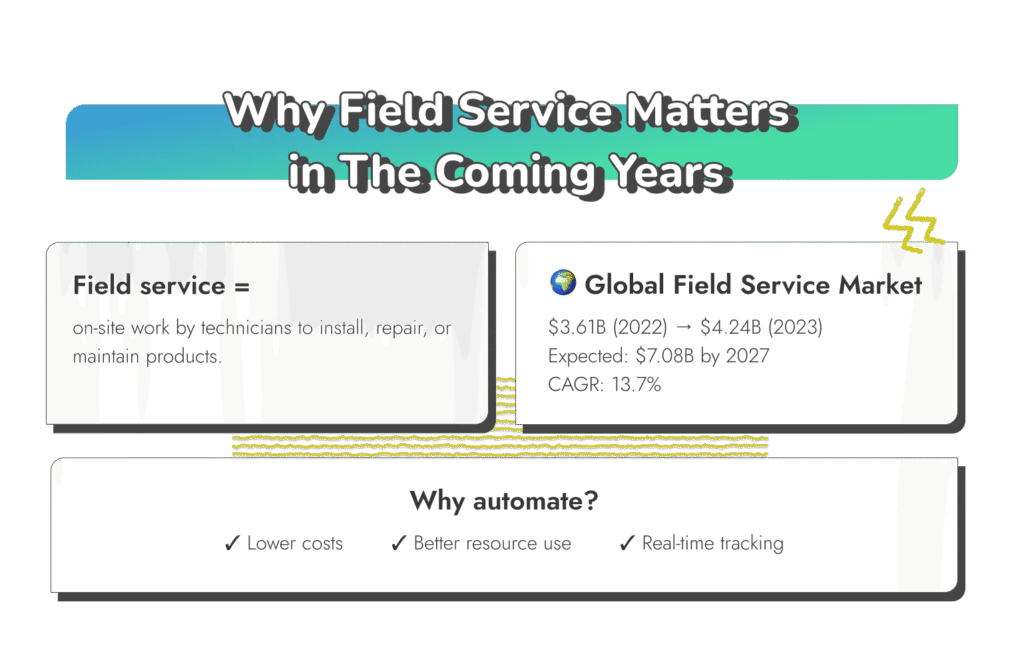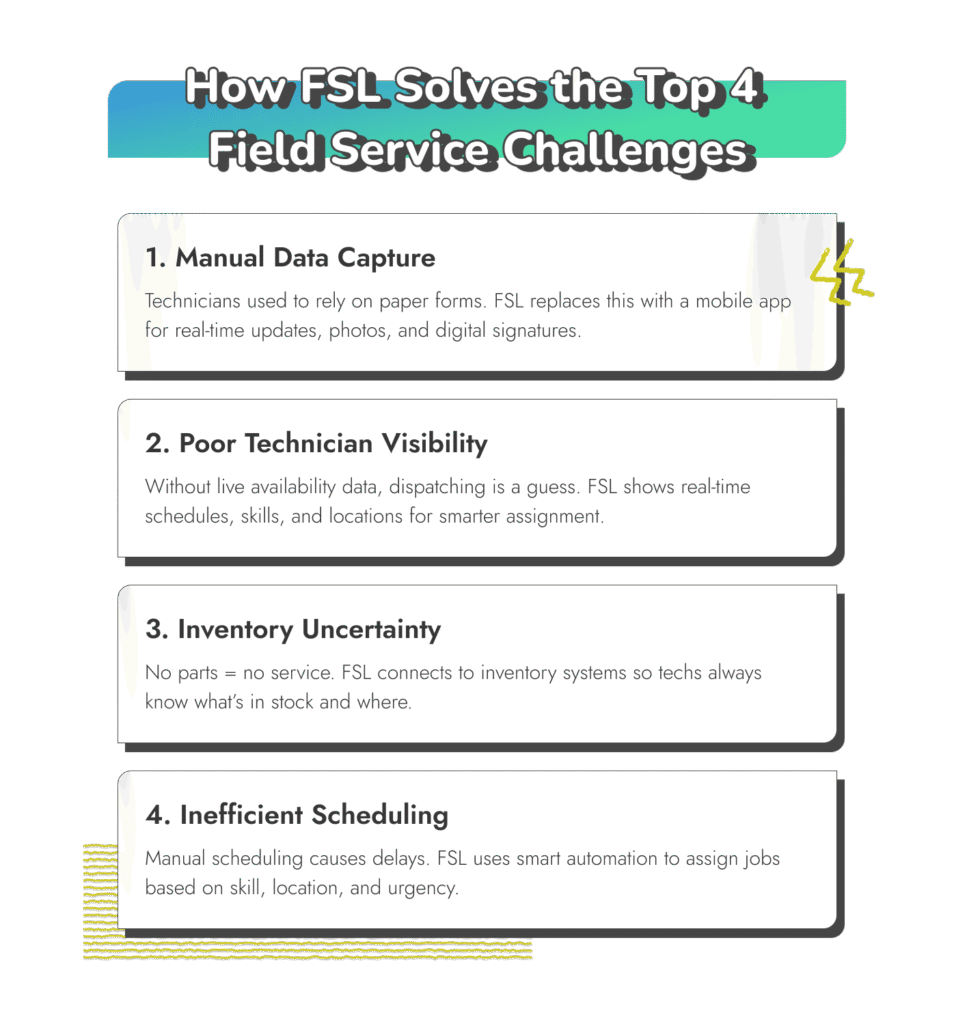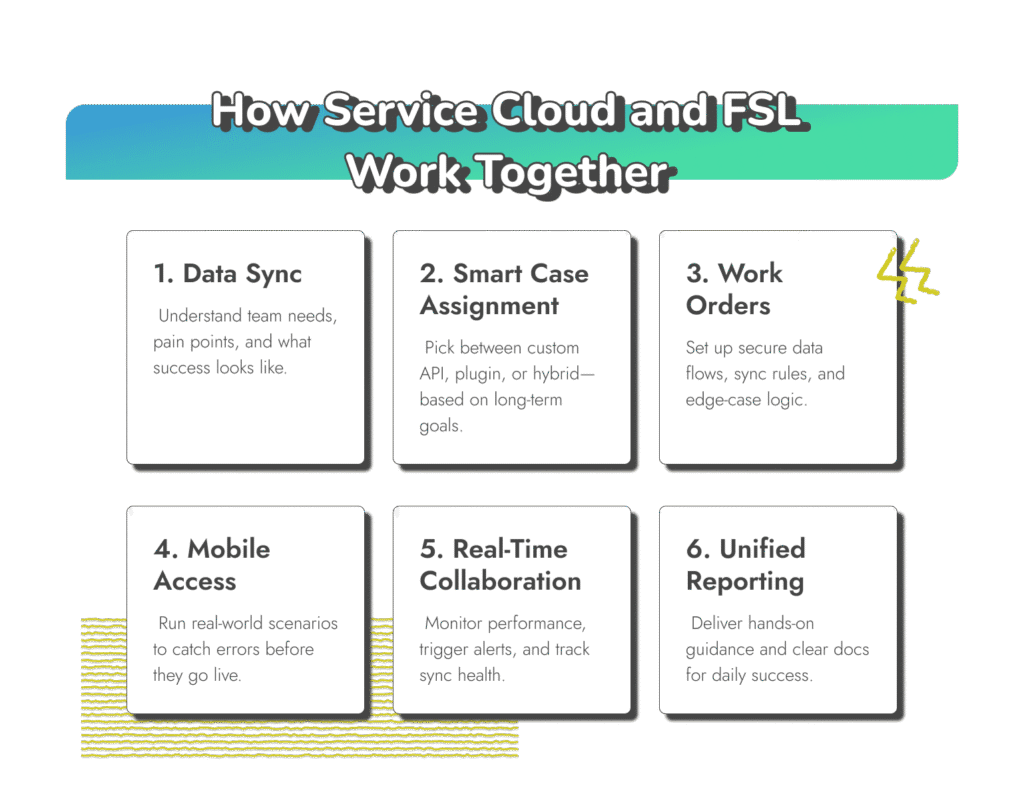A Deep Dive into Salesforce Field Service Lightning

In today’s fast-paced and highly competitive business landscape, organizations across industries are constantly seeking ways to enhance their customer service and optimize their field service operations. Whether you’re a business owner, service manager, or IT professional, understanding the capabilities of Field Service Lightning can be the catalyst for driving efficiency, improving customer satisfaction, and maximizing operational productivity. But first, let’s start with field service.
What is Field Service?
Field service represents operations and activities performed by employees or technicians who work directly in the field or at customer locations and applies to industries providing complex products or services that require on-site expertise. The primary goal of field service is to ensure customer satisfaction by promptly addressing issues, maintaining equipment, and providing necessary assistance.

According to the Field Service Management Global Market report the global field service management market has grown from $3.61 billion in 2022 to $4.24 billion in 2023 at a compound annual growth rate (CAGR) of 17.4% and is expected to grow to $7.08 billion in 2027 at a CAGR of 13.7%.
Why it’s essential to adopt automation in field service?
★ Cut down on operational costs
★ Optimal resources utilization
★ Boosted tracking and monitoring
Implementing field service management software and thus delivering automation empowers organizations to optimize scheduling, track and manage field activities, increase first-time fix rates, reduce response times, and ultimately drive customer satisfaction and loyalty.
Salesforce Field Service Lightning: Meaning & Purpose
Field Service Lightning is a cloud-based software designed by Salesforce to coordinate resources to deliver in-person service for equipment installation, maintenance, break/fix, and asset monitoring. Performing these jobs takes careful coordination between agents, dispatchers, workers, and others.
Who can use Field Service Lightning?
Responsible for responding to customers’ “work orders” such as service call-outs. Dispatchers select the right person for the job based on factors – skill, availability, proximity to the site, etc.
Specialists responsible for carrying out the service (for example, installation crew).
Handle communication with customers when they request a service call-out. Agents can validate the need for a call-out, or determine whether there is an alternative, simpler resolution.
Monitor service call-out volume, service efficiency (i.e., the time the technician spent at the site and travel time), and customer satisfaction.

See how our team helps businesses implement, configure, and fine-tune Field Service Lightning — from smart scheduling to mobile technician support.
4 Key Challenges to Overcome with FSL
Salesforce Field Service Lightning (FSL) addresses several challenges related to field service operations. Let’s explore how FSL can tackle these key challenges:

1. In-field manual data capturing
Field technicians traditionally rely on manual processes for data capture, such as paper forms or spreadsheets, which can be time-consuming, error-prone, and inefficient. FSL provides a mobile app that enables technicians to capture and update data directly in the field. They can record service details, capture customer signatures, take photos, and input data in real-time using their mobile devices.
2. Technician team capacity limited visibility
Without proper visibility into technician availability and workload, it becomes challenging to efficiently assign work orders and balance the workload among the technician team. FSL addresses this by providing a centralized scheduling and dispatching system. It allows service managers to view technician schedules, skill sets, and availability in real-time.
3. Problems with inventory needs
Field technicians often face challenges related to inventory management, including knowing the availability of required parts, tracking stock levels, and ensuring timely replenishment. FSL integrates with inventory management systems, providing real-time visibility into inventory levels and locations. Technicians can access this information through the FSL mobile app, ensuring they have the necessary parts and equipment on hand to complete service jobs effectively.
4. Ineffective scheduling and resource allocation
Manual or inefficient scheduling and resource allocation can lead to delays, inefficiencies, and missed service commitments. FSL’s intelligent scheduling and resource allocation capabilities optimize these processes. By considering factors such as technician skills, location, availability, and customer priority, FSL automatically assigns and optimizes the scheduling of work orders.

From manual reports to automated workflows – see how Routine Automation streamlined Profil’s service management.
Salesforce FSL Features to highlight
Scheduling & Dispatching. With the Field Service Lightning solution designed by Salesforce, your company can achieve efficient technician scheduling by precisely matching technicians’ skills to the appropriate locations.
Inventory Management. Field Service Lightning empowered you to effectively track inventory requirements for every dispatched team.
In-field data capturing. By leveraging Salesforce Field Service Lightning, your company gets automated in-field data capturing, eliminating the cumbersome process of manually transferring data from Excel spreadsheets and paper forms.
Field Service Lightning Mobile app. With the FSL mobile app, your technicians have a comprehensive view of their assigned work orders, enabling them to stay organized and prioritize tasks effectively. They can access customer details, service history, and job requirements right from their mobile devices.
Salesforce Service Cloud & FSL interaction
If you are already a Service Cloud user and thinking about implementing FSL as a field management solution, you can use them together to streamline customer service operations. Here’s how they interact:

🚀 Data Synchronization
Salesforce Service Cloud serves as the central hub for customer service activities, including case management, knowledge base, and customer interactions. When a case is created or updated in Service Cloud, relevant information such as customer details, case status, and service history is automatically synchronized with Salesforce FSL. This ensures that field technicians have access to the most up-to-date customer information while in the field.
🚀 Case Assignment and Scheduling
Service Cloud’s case management functionality allows customer service agents to triage and assign cases based on priority, skill set, and other criteria. Once a case is assigned to a field technician, FSL takes over for efficient scheduling and dispatching. FSL considers factors like technician availability, location, skills, and service level agreements (SLAs) to optimize scheduling and ensure the right technician is assigned to each job.
🚀 Work Order Management
Salesforce Service Cloud enables the creation and management of work orders, which represent the specific tasks or jobs that need to be performed in the field. These work orders can be associated with cases in Service Cloud, allowing a seamless handoff between customer service and field service teams. FSL Salesforce utilizes work orders to track and manage field service tasks, ensuring that technicians have clear instructions and can efficiently complete their assigned work.
🚀 Mobile Enablement
Salesforce Field Service Lightning extends the capabilities of Service Cloud to the field by providing a mobile app for field technicians. The mobile app enables technicians to access work orders, view customer information, update job status, capture signatures, and even generate invoices on-site. Any changes made in the field through the FSL mobile app are synchronized back to Service Cloud in real-time, ensuring data integrity and visibility for both field and service teams.
🚀 Real-time Communication and Collaboration
Service Cloud and FSL facilitate real-time communication and collaboration between field technicians and customer service agents. Through integration, technicians can communicate with service agents, request assistance, and access knowledge articles or documentation related to a particular case or work order. This seamless communication streamlines issue resolution and enables better coordination between field and service teams.
🚀 Reporting and Analytics
Both Service Cloud and FSL provide robust reporting and analytics capabilities. Service Cloud offers reports and dashboards to track key performance metrics, customer satisfaction, and case resolution times. FSL provides additional field service-specific reports, such as technician productivity, job completion rates, and first-time fix rates. The integration between the two allows for comprehensive reporting and analysis across the entire service operation.


















